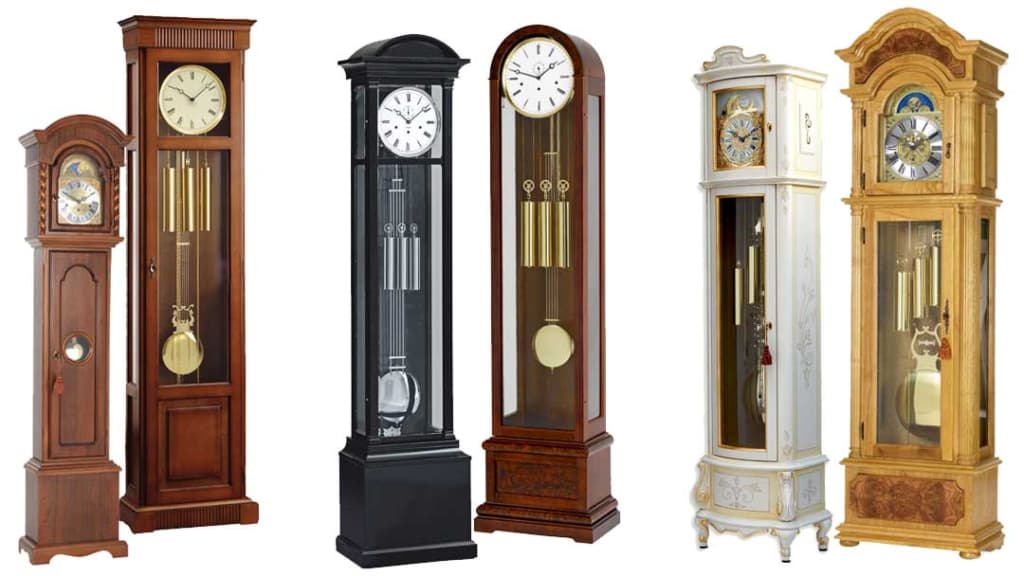The apex or topmost segment of a grandfather clock bears a specific designation – the crown. There are four principal styles associated with these crowns: split pediment, bonnet, flat, and federal. Each style offers unique aesthetics and historical significance.
Split Pediment Crown
Mirroring the graceful bends of a swan’s neck, the Split Pediment Crown is an elegant feature, often distinguished by its dual curved design. The central part usually houses an ornate piece called the finial, occasionally designed as an eagle. Some designs include twin finials on either side, termed spires, which are typically sculpted from wood or brass.
Bonnet Crown
Encompassing the clock’s face, the Bonnet Crown, sometimes termed the ‘hood,’ features a complete arch at its forefront. It predominantly echoes the classic aura associated with age-old grandfather clock designs.
Flat Crown
Evoking simplicity, the Flat Crown traces its origins back to the early 1700s. Its straightforward design makes it a favorite for both contemporary and classical decors, positioning it as a versatile choice for various interiors.
Federal Crown
Characterized by its apex-like front, the Federal Crown stands out as the centerpiece of the clock. Although this crown exudes sophistication, it’s less prevalent in today’s manufacturing sphere.
Comparative Analysis of Clock Crowns
| Crown Type | Description | Period Origin | Popularity |
|---|---|---|---|
| Split Pediment | Swan-like curves with central finial | Classic | High |
| Bonnet | Full arched front, often called ‘hood’ | Traditional | Moderate |
| Flat | Simplistic, versatile design | Early 18th Century to Present | High |
| Federal | Pinnacle front, primary focus | Classic | Low |
Historical Evolution of Grandfather Clock Crowns
The aesthetic of the grandfather clock has undergone considerable transformation since its inception. Notably, the crown’s design evolution mirrors societal changes and artistic trends. Initially, during the Renaissance, ornate and intricate designs were favored, symbolizing affluence and artistry. As the Industrial Revolution dawned, there was a noticeable shift towards functional, minimalist designs, reflecting society’s growing emphasis on utility over opulence. Today, with the advent of modernism and post-modernism, there’s a balanced fusion of past and present in crown designs, blending traditional motifs with contemporary aesthetics. Thus, the crown’s evolution serves as a captivating window into changing epochs and cultural shifts.
The Artistry Behind Crafting a Clock Crown
Crafting a grandfather clock crown demands a blend of meticulous precision and artistic flair. Artisans often draw inspiration from architectural masterpieces, natural elements, and historical motifs. The process commences with sketching a blueprint, which evolves into a wooden prototype. Precision tools and age-old handcrafting techniques are employed to carve intricate details, ensuring the crown’s symmetry and elegance. Materials play a pivotal role too. While wood remains the classic choice, contemporary designs incorporate metals and even ceramics, each adding a unique touch to the finished piece. Thus, behind every crown lies an intricate tale of craftsmanship and creativity.
Choosing the Perfect Crown for Your Space
Selecting the ideal grandfather clock crown extends beyond aesthetics. It’s essential to factor in the room’s size, decor, and overall ambiance. For spacious rooms with vintage decor, a Split Pediment or Federal Crown can amplify the regal aura. Conversely, modern minimalist spaces might resonate better with a Flat Crown. The room’s color palette also matters. Darker woods like mahogany or walnut complement rooms with warm tones, while lighter woods like oak or pine align with cooler shades. Furthermore, consider the clock’s placement. In rooms with lower ceilings, a flat or bonnet crown might be more fitting, while lofty spaces can accommodate intricate split pediments. In essence, the crown should seamlessly blend with its surroundings while making its unique statement.
Video Guide
In order to answer all your questions, we have prepared a special video. Enjoy watching it!
Conclusion
The grandiosity of grandfather clocks isn’t merely in their stature but also in the intricate details of their crowns. These crowns, with their varying styles from the swan-like curvatures of the Split Pediment to the minimalist elegance of the Flat Crown, encapsulate centuries of history, craftsmanship, and aesthetic evolution. While each style has its own story and character, what remains constant is their ability to elevate the beauty of spaces they inhabit. The choice of crown speaks volumes about one’s personal style, decor preferences, and even historical inclinations. As we’ve traversed through the uniqueness of each type, the underlying lesson is clear: the crown, though perched atop, is central to a grandfather clock’s identity. Whether you’re an avid antique collector or someone with a penchant for timeless decor, selecting the right crown is pivotal. In the end, it’s not just about telling time; it’s about making a statement of grandeur, legacy, and taste.
